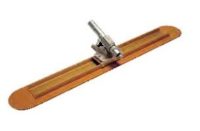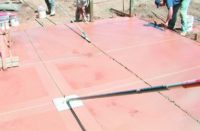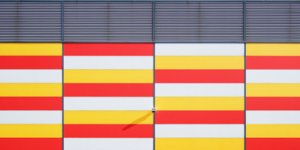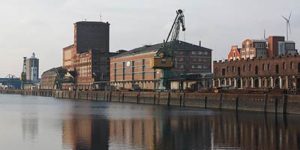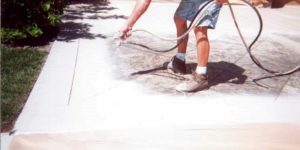Decorative concrete artisans are not only a creative bunch. They also are quick to figure out if there’s a better way to do something. Some of our top 10 noteworthy products from recent years are about more-efficient production while others involve cool technology that we hope will soon make its way into the forefront of daily work.
1. Photocatalytic or Self-Cleaning Concrete
Concrete is the single most widely used building material in the world, yet concrete is easily discolored and damaged by pollution and minerals in rainfall. New formulations of cement are able to neutralize pollution, turning the harmful particulates into harmless compounds that are washed away by rain.
This technology is based on the use of titanium dioxide particles, which catalyze the breaking down of pollutants that attach themselves to concrete surfaces. As sunlight hits the surface, the pollutants are neutralized. This TiO2-enhanced cement can be used in place of regular portland cement in any application.
Self-cleaning concrete is currently being used to coat the Sarajevo Bridge, a bridge spanning a major road in Barcelona, Spain. The Air France offices at Charles de Gaulle airport near Paris and the Church of 2000 in Rome also employ a similar technology.
In addition to keeping surfaces clean, photocatalytic coatings can improve air quality. This technology can be seen on the Italian pavilion at the Milan Expo 2015, which runs from May until October. Material manufacturer Italcementi has a patent on the air-cleaning cement on the facade.

2. Proline Concrete Tools Magnetic Texture Mats
Proline Concrete Tools originated the seamless texture mat, and now it’s taken it one step farther with a lightweight, durable polymer magnetic texture mat. This is a mat with a feathered edge stamp that also supplies a texture. These stamps can simply overlap each other for a textured finish without seams. The new mats connect to each other with magnets, making the work even easier and more foolproof.

3. LithoMosaic
LithoMosaic inventor Robin Brailsford knew there had to be a better way to get a design into concrete other than hand-tossing buckets of aggregates into wet mud. Riffing off of LithoCrete, a process developed by Shaw & Sons that entails scattering aggregate on the surface of wet concrete, Brailsford discovered a way to make a deliberate pattern that could be created in the studio and placed in monolithic concrete pours.
After nearly five years of working with Shaw & Sons and T.B. Penick & Sons, they created the patented process known as LithoMosaic. Since then, the process has been used to create hundreds of concrete art pieces around the country.
4. Soy-Based Products
With a lot of contractors now looking for green alternatives to solvent-based products, soy-based stains and coating removers are gaining ground in the decorative concrete industry. Not only are these products made with a rapidly renewable resource — soybeans — they have a higher coverage rate compared to their traditional counterparts and are safer for everyone involved.
For instance, SoyCrete, a penetrating concrete stain from Eco-Safety Products, delivers the variegated look of an acid stain in less time without the associated mess and hazardous ingredients. SoyCrete is also much easier to control than acid stain, with more consistent results. Available in 35 standard colors and endless custom blends, it’s destined to be a game changer. The green building-compliant product works as well if not better than its conventional counterparts while being cost-competitive, safer and very durable.
Also in the vegetable-based lineup of impressive products is 600GL, a soy-based coating remover from Franmar. The company’s most popular product, the powerful yet non-caustic gel will remove multiple layers of topical sealers, acrylics, enamels, urethanes, latex and some epoxies in one application. And 600GL is not only made in the U.S. — it’s made with soybeans grown in the U.S.
5. AmeriPolish’s Penetrating Curing Agent
Concrete needs to be cured, especially for slabs that are to be acid stained or colored. But then, any curing agent needs to be removed in order for the acid stain to penetrate. Materials that prevent water from leaving the surface are what have traditionally been used, but now there’s a new approach. AmeriPolish PCA (penetrating curing agent) chemically hardens and dust-proofs concrete without forming a coating. PCA can be used with integrally colored concrete and doesn’t need to be removed with chemical strippers or abrasives like traditional topical curing products.

6. Metallic Coatings
Today’s metallic-looking coatings, which provide drift and sparkle and can be used to create an impressive 3-D look, continue to gain traction in the decorative concrete industry. The facts that they are so easy to use and come in a broad palette of colors contribute to their popularity. So does the reasoning that they can be a less-expensive and viable alternative to overlays and stains for floors in bad shape.
They are made with a wide range of ingredients including aluminum pigments, various other metals, liquid colorants, mica or synthetic mica particles coated with colors or a complex combination of these components. Most are used with epoxies and allow contractors to achieve a controllable acid-stain look without all the mess.
Many of today’s metallic coatings self-level and dry fast without compromising the integrity of the coating. The beauty of metallics is that although the finish looks complicated and advanced, the installation is quite simple once you get the hang of it. Most will produce a variegated look in a straight-forward application, although many contractors achieve stunning results with a little manipulation.

7. Soldier Curve Tools from Butterfield Color
Contractors no longer have to fret about getting those “soldiers” in line correctly when customers choose a soldier course pattern on a radius-filled hardscape with more than its share of twists and turns. Butterfield’s new flexible Soldier Curve Tools automatically adjust brick angles and conform to whatever radius they meet. These time-saving tools, which eliminate having to hand cut borders, are designed to be used with their correlating soldier course border patterns and Butterfield’s Brick Texture Roller Sleeve. Tools are available in three types: Pennsylvania Avenue, Old Chicago and New Brick.

8. Pervious Concrete
In this day and age where environmentally friendly products rule, pervious concrete is making headway. However, you don’t often hear the words decorative and pervious in the same sentence.
Pervious concrete, a specialized pavement mix that allows water and air to easily pass through a maze of interconnected voids, typically consists of portland cement, 3/8-inch coarse aggregate, water and admixtures to improve placeability. Whereas the basic mix is more expensive than traditional concrete, pervious pavements can reduce the need for retention basins and storm-water drainage systems.
Pervious systems also can help filter out pollutants, replenish local aquifers and improve plants’ access to air and water. Safety-wise, it eliminates standing puddles.
With all these pluses, contractors may be able to persuade clients that a pervious job can look pretty, too, with a little extra investment. Integral color is the best way to go as stains would flow right through the mix and color hardener is out of the question because pervious is too dry. The material can be stamped but you have to be quick. It sets up in about 20 minutes.
Probably the simplest way to combine pervious and decorative is to design a driveway with a color that complements the house and a stone that’s coarse enough to match the house’s texture.

9. Ductal
Incredibly strong, durable and ductile (hence its name) best sum up the key characteristics of Ductal, a family of ultra-high performance concretes from Lafarge. Blended with organic or metallic fibers, it is significantly stronger than conventional concrete. Architects, designers and decorative concrete artisans can specify or use the material to create thinner sections and longer spans with graceful curves and innovative forms without the need for passive reinforcement. To top things off, it also has a remarkably long life.
Designed and developed for structural or architectural applications, Ductal solutions are often cutting edge and may be used in a range of new construction or renovation projects including facades, interior design elements, urban furnishings, bridges and more. It can be integrally colored and fashioned to produce extremely fine textured surfaces.
Ductal is much denser than conventional concrete, with extremely low porosity, making it highly resistant to impact, weathering or degradation. Proponents of this material are still discovering new uses for this remarkable mix that blends creativity with technology to get innovative and aesthetically pleasing results.

10. Litracon
We all know that concrete can be manipulated to look like many things, but who would have thought this rock-solid substance could be a substitute for a window?
Litracon, an acronym for “light-transmitting concrete,” is manufactured by the German company of the same name. Invented in 2001 by Hungarian architect Áron Losonczi, it was the first commercially made transparent concrete on the market. Besides the cool factor, practical uses for the see-through concrete include incorporating it in area of a building where you want natural light to come through, such as a fire escape stairwell.
Litracon, which is available as prefabricated building blocks, consists of randomly embedded glass fibers in a proprietary concrete mixture. Because of the inherent characteristic of fiber optics, light doesn’t diminish over the thickness of the material. It will still pass through the same, whether it is 2 or 20 feet thick.
In addition to the original Litracon, which hasn’t caught on as much as its maker predicted at the turn of the century, there is also Litracon pXL, which features a specially formed and patented plastic unit without any optical fibers to transmit light. Instead, the reinforced pXL panels feature regularly distributed dots of light similar to pixels on an LCD screen. Less expensive than Litracon, the panels come in a variety of sizes and can be designed to emit a pattern or logo. They also can be used to create 3-D objects such as furniture.
